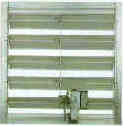

Enthalpy Controls
On many days in the spring and fall when the building requires cooling, the outside air is cooler and dryer than air within the building. In these situations, the percentage of outside air can be increased (often up to 100%) to provide some or all required cooling. An outdoor air economizer operates by regulating the percentage of outside air introduced into the building from a minimum of that required for fresh air to a maximum of 100%. They can operate with cooler outdoor air whenever possible, thus reducing energy used by the compressor to the tune of 10% to 15%.
When considering new air conditioning systems, look for cooling units that have an integrated economizer. An economizer retrofit package or custom fabrication may also be available for your current system from your HVAC supplier. Consult the Thomas Register of American Manufacturers at your local public library for the names and manufacturers of economizers if installing as a retrofit.
 |
Enthalpy Controls Dry bulb economizer controls maximize outside air supply when the building requires cooling and the outside air is cooler than the air in the building. This temperature-focused control strategy does not account for humidity. It can result in greater energy use if the humidity is high, or missed savings when the outside air is relatively dry. Enthalpy controls measure both the temperature and humidity of outside and building air, and select economizer operation based upon the total energy needed to cool/heat the mix of outside and building air. Enthalpy controls can be installed alone or as a component of an Energy Management System (EMS). An EMS enables building owners and operators to control equipment with precision unattainable through manual operation. Installation costs of an EMS system range between $400 and $800 per point. |
|
|

|
| Copyright Aclara Technologies LLC. All Rights Reserved. | |